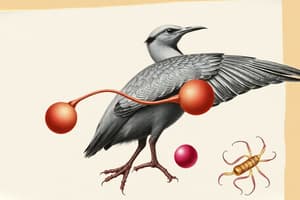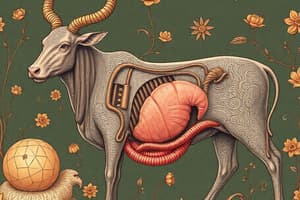Podcast
Questions and Answers
Which of the following is a primary function of the crop in avian digestion?
Which of the following is a primary function of the crop in avian digestion?
- Nutrient absorption, particularly of fats and carbohydrates.
- Secretion of digestive enzymes like pepsin and $HCl$.
- Mechanical breakdown of food particles using muscular contractions.
- Ingesta storage and early microbial digestion. (correct)
What controls the movement of food from the crop to the proventriculus in birds?
What controls the movement of food from the crop to the proventriculus in birds?
- The amount of salivary amylase present in the crop.
- The bird's circadian rhythm.
- The fullness of the proventriculus and intestines (feedback long reflex). (correct)
- The pH level of the ventriculus.
Which anatomical feature is typically absent in owls and insectivorous birds concerning the esophagus?
Which anatomical feature is typically absent in owls and insectivorous birds concerning the esophagus?
- Glandular stomach.
- Cloaca.
- Ventriculus.
- Crop. (correct)
What is the primary function of the ventriculus (gizzard) in avian digestion?
What is the primary function of the ventriculus (gizzard) in avian digestion?
What is a unique characteristic of the avian ileum?
What is a unique characteristic of the avian ileum?
What is the cloaca's primary role in birds?
What is the cloaca's primary role in birds?
Which bird species lacks a gallbladder?
Which bird species lacks a gallbladder?
What substance is 'crop milk' primarily composed of, for birds that produce it?
What substance is 'crop milk' primarily composed of, for birds that produce it?
Which of the following best describes the function of reverse peristalsis in the colon of birds?
Which of the following best describes the function of reverse peristalsis in the colon of birds?
What is the primary function of the gizzard's thick muscle contractions in avian digestion?
What is the primary function of the gizzard's thick muscle contractions in avian digestion?
How does reverse peristalsis in the duodenum contribute to the digestive process in birds?
How does reverse peristalsis in the duodenum contribute to the digestive process in birds?
In predatory birds like owls and hawks, what physiological process is associated with the egestion of gastric pellets?
In predatory birds like owls and hawks, what physiological process is associated with the egestion of gastric pellets?
What occurs immediately before defecation in birds, with regards to colonic motility?
What occurs immediately before defecation in birds, with regards to colonic motility?
Flashcards
Crop
Crop
An enlargement in the esophagus for storage of ingesta in birds.
Proventriculus
Proventriculus
The glandular stomach in birds, located before the muscular stomach.
Ventriculus
Ventriculus
Also known as the gizzard, it's the muscular stomach for grinding food.
Ceca
Ceca
Signup and view all the flashcards
Gallbladder in Birds
Gallbladder in Birds
Signup and view all the flashcards
Digestion in Crop
Digestion in Crop
Signup and view all the flashcards
Gastroduodenal cycle
Gastroduodenal cycle
Signup and view all the flashcards
Long Reflex in Digestion
Long Reflex in Digestion
Signup and view all the flashcards
Gizzard Function
Gizzard Function
Signup and view all the flashcards
Peristaltic Waves
Peristaltic Waves
Signup and view all the flashcards
Reverse Peristalsis
Reverse Peristalsis
Signup and view all the flashcards
Colonic Motility
Colonic Motility
Signup and view all the flashcards
Cecum Functions
Cecum Functions
Signup and view all the flashcards
Study Notes
Avian Digestion
- Birds lack teeth, but have a ventriculus (with grit)
- Some birds have a crop (esophagus enlargement, absent in some)
- A glandular stomach (proventriculus) is located near the muscular stomach (gizzard)
- Duodenal loop and jejunum/ileum regions aren't distinctly different in muscles
- Most birds have paired ceca
- A short colon empties into the cloaca (urine and feces)
- Most birds have gallbladders (exceptions include pigeons)
Crop Physiology
- Crop is used for food storage (similar to a proximal stomach)
- Food moves from the crop to the proventriculus
- Movement is controlled by fullness signals in the proventriculus and intestines
- Regurgitation is possible (like "crop milk") to feed young
- High-fat content in regurgitated "milk" from some species
Gastroduodenal Cycle
- Thin gizzard muscles contract in 2-3 peristaltic waves
- Thick gizzard muscles contract, grind, and reflux food for further digestion
- Some birds (hawks, owls) regularly regurgitate indigestible materials (like bone and hair) as pellets
- Gastric pellets are formed and expelled, and regular peristaltic waves occur (back and forth) to digest food within the proventriculus
- Reverse peristalsis occurs every 15 minutes
- Duodenal content cycles back to the gizzard for further gastric digestion
Colonic Motility
- Constant reverse peristalsis pushes contents towards the ceca and the cloaca.
- Water and salt are absorbed alongside fermentation in the ceca
- Reverse peristalsis stops in preparation for defecation and the whole colon contracts during defecation.
Studying That Suits You
Use AI to generate personalized quizzes and flashcards to suit your learning preferences.




